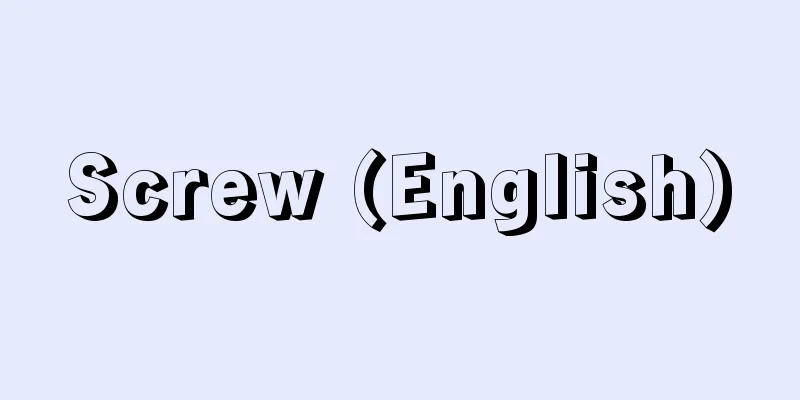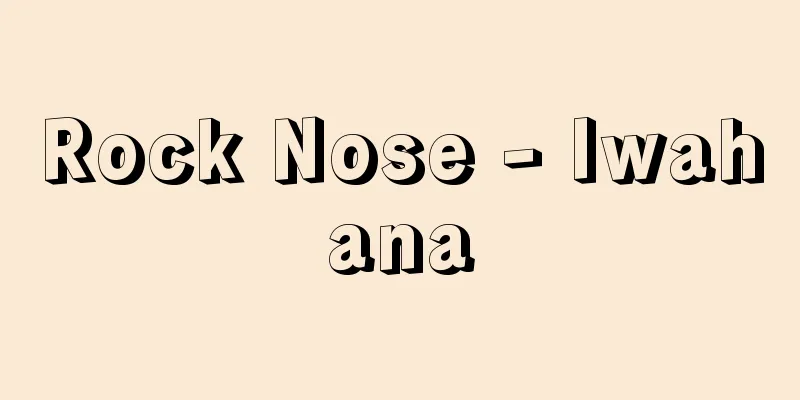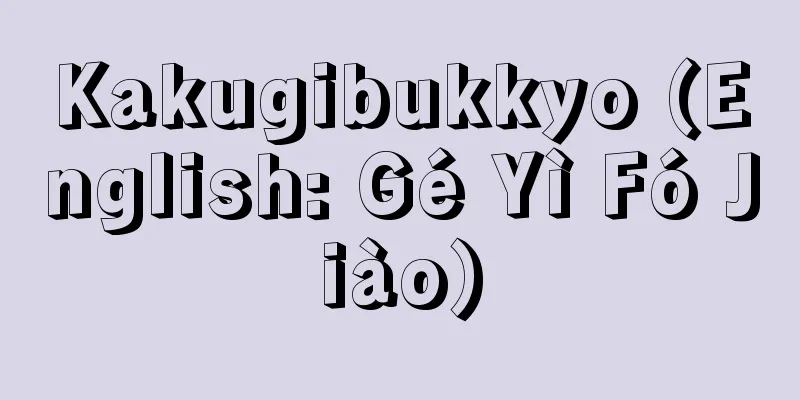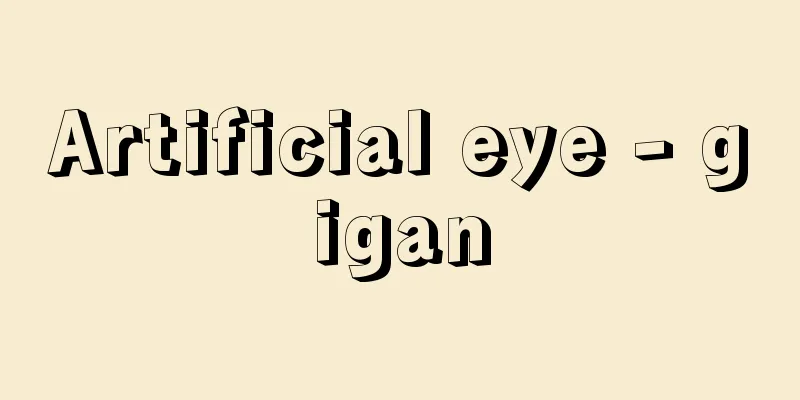Screw (English)

|
A spiral groove on the surface of a cylinder. It can also be written as neshi, neshi, or toji. A cylinder with grooves on the outer surface is called a male thread, and a cylinder with grooves on the inner surface is called a female thread. The spiral protrusion created when the grooves are made is the thread. A cone with threads on its surface is called a tapered thread. A thread with threads that recede when traced clockwise, i.e. to the right, as viewed from the end of the shaft, is called a right-handed thread, and a thread with threads that move away from the end is called a left-handed thread. Since people often turn screws with their right hand, simply speaking of a thread, it refers to a right-handed thread. A thread with one spiral thread is called a single-start thread, one with two is called a double-start thread, one with three is called a triple-start thread, and one with three or more is called a multiple-start thread. The distance from the center of adjacent threads is called the pitch. The distance that a thread advances in the axial direction when it rotates once around its axis is called the lead. For single start threads, the lead is equal to the pitch, but for double start and multiple start threads, the lead is the pitch multiplied by the number of starts. Since screws are used in a wide variety of applications as functional parts of machine components, their dimensions and shapes are determined by standards. Screw dimensions are usually expressed in terms of the outside diameter. A 10 mm screw refers to a screw with an outside diameter of 10 mm. The shape and pitch of the thread are determined based on the outside diameter, and in Japan, screw standards are set out in the JIS (Japanese Industrial Standards). Each type of thread is called by its own name depending on the shape of the thread. Triangular threads, which are mainly used for fastening, are called triangular threads. There are large and small pitch threads for the same diameter, with the larger one being called coarse threads and the smaller one being called fine threads. Fine threads have a finer ratio of pitch to diameter than coarse threads. Bolts and nuts are used to fasten two or more parts together, and most of the threads used for these are coarse threads. Fine threads are used when the overall length of the threaded part is extremely short, when it is necessary to prevent loosening, or when it is necessary to increase the accuracy of position adjustment. Square threads are used when the threads are square, and because they have less friction, they are often used in vices, press jacks, and other devices that transmit force. Trapezoidal threads, which have trapezoidal threads, are used as lead screws for lathes. There are also round threads used for light bulb caps and other places where dirt and sand are likely to get in. There are also many different head shapes, including hexagonal, square, cylindrical, round, flat head, and flat head. The head has various recesses for turning the screw with a wrench or screwdriver. For example, a screw with a hexagonal hole is called a hexagonal socket, a screw with a cross hole (commonly called a plus) is called a cross recessed screw, and a screw with a single groove (commonly called a minus) is called a slotted screw. There are various types of screw fasteners, depending on the combination of the thread shape, head shape, and recess mentioned above. These screw fasteners include bolts and screws, but the distinction between these names is not clearly defined. In general, screws are relatively small in size and have a small tightening force, and bolts are relatively large in size and have a small tightening force, and bolts are relatively large in size and have a large ... To make screws, small screws are cut using taps and dies, or they can be made by pressing a mold and rolling. Large screws or screws with special shapes are cut using a lathe. Screws are not only used for fastening, but also for changing the speed of rotational motion and generating large force with a small rotational force. They are also used as measuring instruments to precisely measure length, like micrometers, taking advantage of the property that a screw advances one pitch per revolution. Special examples include screw conveyors used to transport powders and screw pumps to transport fluids. The history of the screw is long. It is counted as one of the five simple machine elements along with the lever, wheel, pulley, and inclined plane, and was known in principle as a device for winding up an inclined plane into a cylindrical shape. The screw conveyor and screw pump were also created by Archimedes in the 3rd century BC, and are called Archimedes' water lifting machine (spiral). [Hidetaro Nakayama and Shinji Shimizu] [References] | | | |©Shogakukan "> Main types of screws ©Shogakukan "> Names of each part of a screw ©Shogakukan "> Screw Orientation ©Shogakukan "> Thread Shape Source: Shogakukan Encyclopedia Nipponica About Encyclopedia Nipponica Information | Legend |
|
円筒表面に螺旋(らせん)状に溝を掘ったもの。螺子、捻子、捩子とも書く。円筒の外側表面に溝をつけたものを雄(お)ねじ、円筒の内側表面に溝をつけたものを雌(め)ねじという。溝をつけたときにできた螺旋状の突起がねじ山である。円錐(えんすい)の表面にねじ山をつけたものをテーパーねじという。ねじを軸端方向から見て時計回り、すなわち右回りにたどると遠ざかるようなねじ山をもつねじを右ねじといい、その反対のねじ山をもつねじを左ねじという。人間は右手でねじを回す場合が多いので単にねじといえば右ねじをいう。1本のねじに螺旋状のねじ山が一つあるものを一条ねじ、二つあるものを二条ねじ、三つあるものを三条ねじ、三つ以上あるものは多条ねじという。また隣りあったねじ山の中心から中心までの間隔をピッチという。一つのねじ山がその軸の周りに1回転したときに、ねじ山が軸方向に進む距離をリードという。一条ねじではリードはピッチに等しいが、二条ねじや多条ねじではリードはピッチに条数を掛けた距離となる。 ねじは機械要素部品の機能部としてきわめて多方面に使用されているので、その寸法、形状は規格によって定められている。ねじの寸法は普通外径で表している。10ミリのねじといえば外径が10ミリメートルのねじをいう。外径を基準としてねじ山の形、ピッチなどが決められ、日本ではJIS(ジス)(日本工業規格)にねじの規格が定められている。 ねじ山の形によってそれぞれねじの呼び方がある。主として締め付け用に用いられている三角形のねじ山のものを三角ねじという。同一直径に対しピッチの大きいものと小さいものとがあり、大きいほうを並目ねじ、小さいほうを細目ねじという。細目ねじは直径に対してピッチの割合が並目ねじよりも細かくなっている。二つあるいはそれ以上の部分品を締め付けるものとしてボルト、ナットがあるが、これに用いられているねじは並目ねじが多い。細目ねじは、ねじ部の全長が極端に短い場合や、緩みにくくしたい場合、位置調整精度を高めたい場合などに用いられる。ねじ山が角形のものを角ねじというが、摩擦が少ないので万力、プレス・ジャッキなど力を伝達するものに多く使用される。ねじ山が台形をしている台形ねじは旋盤の親ねじとして用いられている。電球の口金や、ごみや砂の入りやすいところに用いられる丸ねじもある。 また、頭の形状にも、六角、四角、円筒、丸、皿、丸皿など、多くのものが使われている。この頭部には、レンチやドライバーで、ねじを回すための各種くぼみが設けられている。たとえば、六角穴を設けたものは六角穴付き、十文字(一般的にプラスとよばれている)の穴を設けたものは十字穴付き、一文字(一般的にマイナスとよばれている)の溝をつけたものは、すり割り付きなどとよばれている。 ねじ部品には、以上に述べたねじ山状、頭部状とくぼみの組合せにより、各種のものが存在している。これらねじ部品には、ボルトとねじが存在しているが、その名称の使い分けは明確にされていない。一般的に、ドライバーを用いて締め付けるような、締付力が小さく比較的小さなサイズのものをねじとよび、逆に、スパナやレンチを用いて締めつけるような、締付力やサイズが比較的大きなものをボルトとよんでいるようである。 ねじをつくるのには、小さなねじはタップとダイスを用いて切削する。また型を押し付け転造してつくることもある。大形のねじ、または特殊な形をしたねじは、旋盤を用いて切削してつくる。 ねじの用途は締結用だけでなく、回転運動の速度変換、小さな回転力で大きな力を出したりするのにも用いられる。またねじの1回転で1ピッチ進むという性質を利用してマイクロメーターなどのように長さを精密に測定する測定器としても利用される。特殊なものとして、粉体などの輸送に応用されているねじコンベヤー、流体を輸送するねじポンプなどがある。 ねじの歴史は古い。てこ、車輪、滑車、斜面とともに五つの単一機械(単純機械)要素に数えられ、原理的には斜面を円筒形に巻き上げたものとして知られていた。ねじコンベヤー、ねじポンプも、すでに紀元前3世紀にアルキメデスによってつくられて、アルキメデスの揚水機(螺旋)とよばれている。 [中山秀太郎・清水伸二] [参照項目] | | | |©Shogakukan"> ねじのおもな種類 ©Shogakukan"> ねじの各部名称 ©Shogakukan"> ねじの向き ©Shogakukan"> ねじ山の形状 出典 小学館 日本大百科全書(ニッポニカ)日本大百科全書(ニッポニカ)について 情報 | 凡例 |
<<: Nejiki (twisted wood) - Lyonia ovalifolia
Recommend
Russian literature
The history of Russian literature, which spans al...
Gengo Ohtaka
1672-1703 A samurai from the early Edo period. Bo...
Namur - Namur (English spelling)
The capital of the province of Namur in south-cen...
Okura Shoji - Okura Shoji
A general trading company focusing on steel and ma...
Asuhamichi - Asuhamichi
…It has long been known as a strategic point on t...
Geochelone elephantopus
… [Takahiro Matsui]. … *Some of the terminology t...
Trio sonata (English spelling) [Italian]
A sonata written in three parts during the Baroque...
Formant (English spelling)
A frequency component or collection of components ...
Hikawa [town] - Hikawa
A former town in Hikawa County, eastern Shimane Pr...
Trolley bus - toro-ri-bus (English spelling)
A rail vehicle that does not require rails to run...
Oral phase
This is the first stage of psychosexual developme...
Yuè Zhongqi (English name)
1686‐1754 A military commander in the mid-Qing dyn...
Bear Bracken - Bear Bracken
A perennial fern of the Dryopteris family (illustr...
Casale method - Kazareh method
...A compound of nitrogen and hydrogen. Chemical ...
Munari, B. (English spelling) MunariB
…Finland's Jansson, Denmark's Petersen, E...









